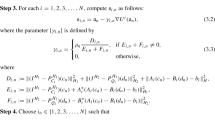Abstract
We investigate a one-parametric class of merit functions for the second-order cone complementarity problem (SOCCP) which is closely related to the popular Fischer–Burmeister (FB) merit function and natural residual merit function. In fact, it will reduce to the FB merit function if the involved parameter τ equals 2, whereas as τ tends to zero, its limit will become a multiple of the natural residual merit function. In this paper, we show that this class of merit functions enjoys several favorable properties as the FB merit function holds, for example, the smoothness. These properties play an important role in the reformulation method of an unconstrained minimization or a nonsmooth system of equations for the SOCCP. Numerical results are reported for some convex second-order cone programs (SOCPs) by solving the unconstrained minimization reformulation of the KKT optimality conditions, which indicate that the FB merit function is not the best. For the sparse linear SOCPs, the merit function corresponding to τ=2.5 or 3 works better than the FB merit function, whereas for the dense convex SOCPs, the merit function with τ=0.1, 0.5 or 1.0 seems to have better numerical performance.
Similar content being viewed by others
References
Alizadeh, F., Goldfarb, D.: Second-order cone programming. Math. Program. 95, 3–51 (2003)
Alizadeh, F., Schmieta, S.: Symmetric cones, potential reduction methods, and word-by-word extensions. In: Wolkowicz, H., Saigal, R., Vandenberghe, L. (eds.) Handbook of Semidefinite Programming, pp. 195–233. Kluwer Academic, Boston (2000)
Andersen, E.D., Roos, C., Terlaky, T.: On implementing a primal-dual interior-point method for conic quadratic optimization. Math. Program. 95, 249–277 (2003)
Chen, J.-S., Tseng, P.: An unconstrained smooth minimization reformulation of the second-order cone complementarity problem. Math. Program. 104, 293–327 (2005)
Chen, J.-S., Chen, X., Tseng, P.: Analysis of nonsmooth vector-valued functions associated with second-order cone. Math. Program. 101, 95–117 (2004)
Chen, X.-D., Sun, D., Sun, J.: Complementarity functions and numerical experiments for second-order cone complementarity problems. Comput. Optim. Appl. 25, 39–56 (2003)
Facchinei, F., Pang, J.-S.: Finite-Dimensional Variational Inequalities and Complementarity Problems, vols. I and II. Springer, New York (2003)
Ferris, M.C., Mangasarian, O.L., Pang, J.-S. (eds.): Complementarity: Applications, Algorithms and Extensions. Kluwer Academic, Dordrecht (2001)
Fukushima, M., Luo, Z.-Q., Tseng, P.: Smoothing functions for second-order cone complementarity problems. SIAM J. Optim. 12, 436–460 (2002)
Grippo, L., Lampariello, F., Lucidi, S.: A nonmonotone line search technique for Newton’s method. SIAM J. Numer. Anal. 23, 707–716 (1986)
Hayashi, S., Yamashita, N., Fukushima, M.: A combined smoothing and regularization method for monotone second-order cone complementarity problems. SIAM J. Optim. 15, 593–615 (2005)
Kanzow, C., Kleinmichel, H.: A new class of semismooth Newton-type methods for nonlinear complementarity problems. Comput. Optim. Appl. 11, 227–251 (1998)
Lobo, M.S., Vandenberghe, L., Boyd, S., Lebret, H.: Application of second-order cone programming. Linear Algebra Appl. 284, 193–228 (1998)
Luo, Z.-Q., Tseng, P.: A new class of merit functions for the nonlinear complementarity problem. In: Ferris, M.C., Pang, J.-S. (eds.) Complementarity and Variational Problems: State of the Art, pp. 204–225. SIAM, Philadelphia (1997)
Mittelmann, H.D.: An independent benchmarking of SDP and SOCP solvers. Math. Program. 95, 407–430 (2003)
Monteiro, R.D.C., Tsuchiya, T.: Polynomial convergence of primal-dual algorithms for the second-order cone programs based on the MZ-family of directions. Math. Program. 88, 61–83 (2000)
Nocedal, J., Wright, S.J.: Numerical Optimization. Springer, New York (1999)
Pataki, G., Schmieta, S.: The DIMACS library of semidefinite-quadratic-linear programs. Preliminary draft, Computational Optimization Research Center, Columbia University, New York. http://dimacs.rutgers.edu/Challenges
Tsuchiya, T.: A convergence analysis of the scaling-invariant primal-dual path-following algorithms for second-order cone programming. Optim. Methods Softw. 11, 141–182 (1999)
Author information
Authors and Affiliations
Corresponding author
Rights and permissions
About this article
Cite this article
Chen, JS., Pan, S. A one-parametric class of merit functions for the second-order cone complementarity problem. Comput Optim Appl 45, 581–606 (2010). https://doi.org/10.1007/s10589-008-9182-9
Received:
Revised:
Accepted:
Published:
Issue Date:
DOI: https://doi.org/10.1007/s10589-008-9182-9




